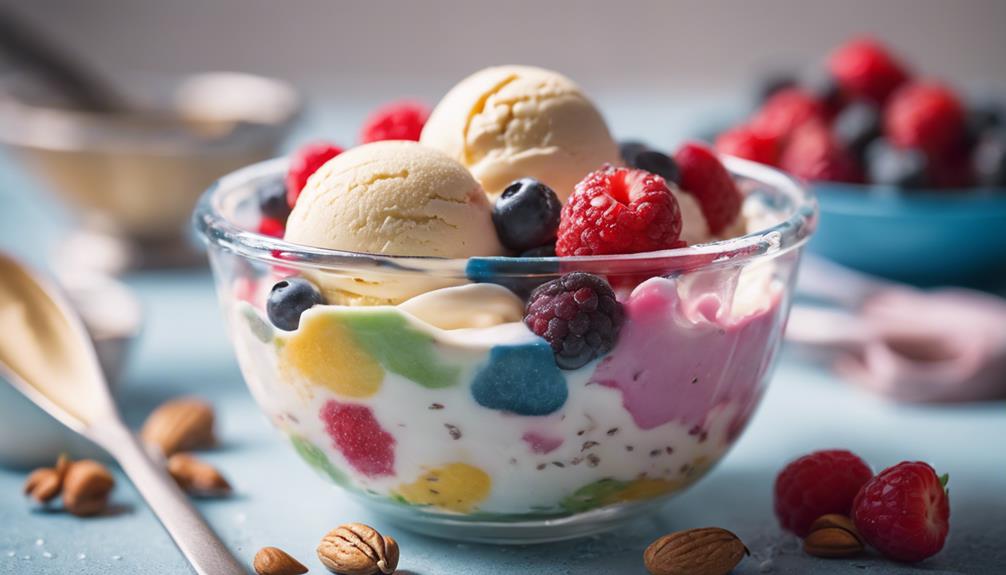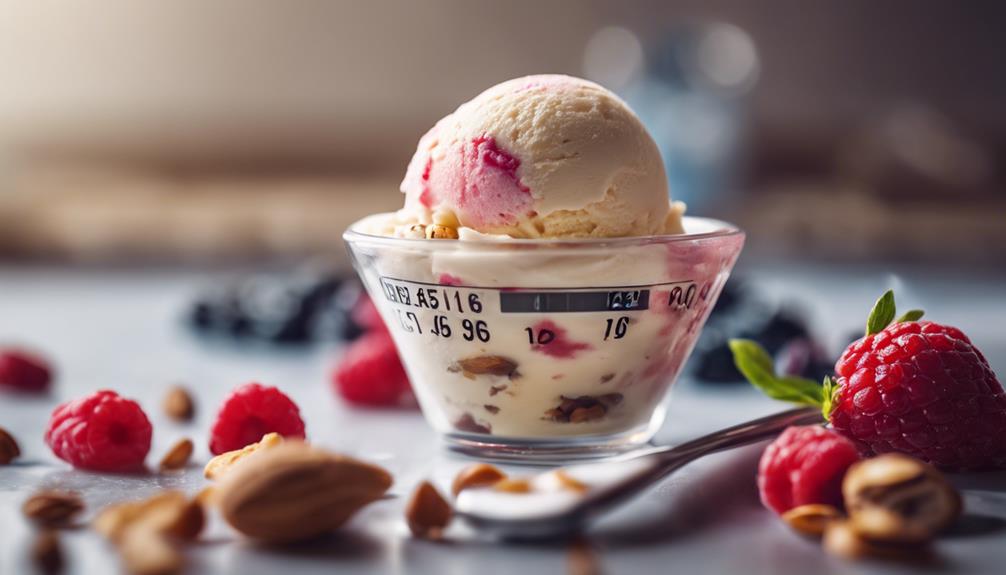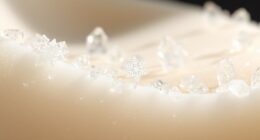When managing diabetes, it’s important to be careful with ice cream as it has the potential to cause spikes in blood sugar levels due to its high carbohydrate content. Consider choosing brands that are lower in sugar and carbs or those that use sweeteners like erythritol. Remember, moderation and controlling portion sizes are essential in controlling sugar levels. It is crucial to balance your ice cream intake with a healthy diet. Check out our suggestions for diabetes-friendly ice cream choices to indulge in a smart way.
Key Takeaways
- Ice cream can cause blood sugar spikes due to high carbs.
- Choose diabetes-friendly options with lower sugar and carbs.
- Portion control is crucial for managing blood sugar levels.
- Include protein-rich toppings for stable blood sugar.
- Moderation allows occasional enjoyment without health risks.
How Ice Cream Affects Blood Sugar

Consuming ice cream can lead to blood sugar spikes in individuals with diabetes due to its high carbohydrate content. When you indulge in ice cream, your blood sugar levels can rapidly rise, especially if you have diabetes. This spike in blood sugar can be problematic for those with insulin resistance, a common issue in individuals with type 2 diabetes.
Over time, consistently high blood sugar levels from consuming too much ice cream can contribute to complications such as heart disease and nerve damage. It's essential for individuals with diabetes to be mindful of their ice cream intake to prevent these adverse effects on their health.
Choosing Diabetes-Friendly Ice Cream

When selecting ice cream suitable for managing diabetes, opt for brands with lower added sugar and carbohydrate content. Choosing diabetes-friendly ice cream options that incorporate nuts can provide additional protein, fiber, and healthy fats to support your overall health.
It's important to adhere to recommended serving sizes to regulate your sugar intake effectively. Look for ice cream varieties that use nonnutritive sweeteners like erythritol as a healthier alternative to traditional sugars, which can help in maintaining lower blood sugar levels.
Enjoying ice cream in moderation as part of a balanced diet is key to managing your blood sugar levels. By making informed choices and being mindful of the nutritional content of your ice cream selections, you can still indulge in this treat while prioritizing your health and well-being.
Tips for Including Ice Cream in Diet

To incorporate ice cream into your diet while effectively managing diabetes, consider these practical tips for making mindful choices that align with your health goals.
When selecting ice cream, opt for options suitable for diabetes with lower added sugar and carbohydrate content. Adding protein-rich toppings like nuts or seeds can help stabilize your blood sugar levels.
It's crucial to adhere to recommended serving sizes to effectively manage your blood sugar. Homemade low-sugar ice cream can be a great substitute as it allows you better control over the ingredients and sugar content.
Ice Cream Health Benefits Analysis

Exploring the potential health benefits of ice cream requires a closer look at existing research and considerations regarding its consumption. While ice cream is often seen as a treat, it can also offer some health benefits when eaten in moderation.
Dairy products, including ice cream, contain essential nutrients like calcium and protein. When choosing ice cream, opt for options with lower added sugars and check the nutrition labels for information on calories and serving sizes.
Some studies suggest that consuming dairy products may be linked to a lower risk of cardiovascular issues. People with diabetes can still enjoy ice cream as part of a healthy diet, but it's important to be mindful of portion sizes and overall sugar intake.
While more research is needed to fully understand the specific health benefits of ice cream, incorporating it into a balanced diet alongside other nutritious foods can be a part of a healthy lifestyle.
Ice Cream and Moderation

When it comes to managing diabetes and enjoying ice cream, moderation is key. Keeping an eye on portion sizes and choosing lower-sugar options can help you incorporate this treat into your diet without causing significant blood sugar spikes.
Moderation in Ice Cream
Enjoying ice cream in moderation is essential for effectively managing blood sugar levels for individuals with diabetes. When it comes to ice cream consumption, moderation is key. Here are three important tips to help you enjoy ice cream responsibly while keeping your diabetes in check:
- Practice Portion Control: Be mindful of your serving size when indulging in ice cream. Opt for smaller portions to prevent spikes in blood sugar levels.
- Pair with a Balanced Diet: Incorporate ice cream treats into a well-rounded diet that includes plenty of fruits, vegetables, lean proteins, and whole grains. This balance can help mitigate the impact of ice cream on your blood sugar.
- Enjoy Occasional Treats: Treat yourself to ice cream occasionally as part of a healthy lifestyle. By savoring your favorite flavors in moderation, you can satisfy your cravings without compromising your diabetes management goals. Remember, moderation is key to enjoying ice cream while prioritizing your health.
Health Benefits Consideration
Incorporating ice cream in moderation can contribute to a balanced diet for individuals managing diabetes. When enjoyed in moderation, ice cream can offer some health benefits. Opt for lower-sugar flavors to help regulate blood sugar levels.
Adding protein-rich toppings like nuts or seeds can enhance the nutritional value of your treat. Remember that portion control is key; stick to recommended serving sizes to prevent overindulging in ice cream.
By practicing moderation and making mindful choices, you can include ice cream in a balanced diet without negatively impacting your diabetes management. Keep in mind that moderation is vital to maintaining a healthy lifestyle while still enjoying your favorite treats.
Ice Cream Selection Process

When selecting ice cream suitable for diabetes management, you need to evaluate key factors like saturated fat, carbohydrates, and added sugar. Assessing these nutritional parameters is essential in making informed decisions about your ice cream selections.
Stay tuned to learn more about the gaps in ice cream research, the significance of overall diet, and the limitations of current studies.
Ice Cream Research Gaps
Exploring the ice cream research gaps involves delving into the intricate process of selecting diabetes-friendly ice cream options that meet specific nutritional criteria and taste preferences.
When considering suitable ice cream choices for diabetes management, the following aspects are essential: First, it is important to choose sugar-free or low-sugar options to help manage blood sugar levels. Additionally, opting for ice creams with high protein and fiber content can help slow down the absorption of sugar into the bloodstream. Understanding food labeling and being mindful of portion sizes can also play a crucial role in making informed ice cream choices for diabetes management. By paying attention to the nutritional information on packaging and portioning out servings accordingly, individuals can better control their intake of carbohydrates and sugars.
- Nutritional Parameters: Ice cream brands like Halo Top Vanilla Bean and Edy's Slow Churned Mint Chocolate Chip were chosen based on specific criteria such as limiting saturated fat to 3g, carbohydrates to 25g, and added sugar to 12g per serving.
- Taste Test Evaluation: A blind taste test conducted by five testers was utilized to assess the taste, appearance, and texture of over 150 ice cream products, ensuring a balance between nutritional quality and palatability.
- Expert Guidance: Insights from experts like Alex Loh, an associate food editor at EatingWell, and registered dietitian Jessica Ball were instrumental in providing expertise on selecting diabetes-friendly ice cream options that align with dietary recommendations.
Overall Diet Importance
Considering the significance of overall diet in managing diabetes, prioritizing the selection of suitable ice cream options plays a crucial role in maintaining nutritional balance. When choosing ice cream, opt for diabetes-friendly varieties that are lower in added sugar and saturated fats to reduce disease risk. To make certain you make an informed decision, look for options that align with specific nutrition parameters recommended for individuals with diabetes, such as limited saturated fat intake and controlled levels of carbohydrates and added sugar per serving.
| Ice Cream Brand | Saturated Fat (g) | Carbohydrates (g) |
|---|---|---|
| Halo Top Vanilla Bean | 2g | 20g |
| Nicks Cookies and Kräm | 2.5g | 22g |
| Edys Slow Churned Mint Chocolate Chip | 3g | 24g |
Research Study Limitations
The selection process for ice cream in the research study involved analyzing over 150 products based on criteria like calories, total fat, and added sugar content. However, despite the thorough approach taken, there are some limitations that are crucial to acknowledge:
- Limited Sample Size: While over 150 ice cream products were reviewed, the study may not encompass the full range of available options in the market, potentially affecting the generalizability of the findings.
- Subjectivity in Taste Testing: The blind taste test conducted, while valuable, relies on individual preferences and perceptions, which may vary among different testers, impacting the overall assessment of the ice creams.
- Expert Opinion Influence: Although expert opinions from individuals like Alex Loh and Jessica Ball were sought, their input, while valuable, may introduce biases based on personal experiences or preferences, potentially influencing the final selection of recommended ice cream brands.
Given these limitations, interpreting the research study findings with a critical eye and an understanding of the constraints inherent in the ice cream selection process is crucial.
Recommended Ice Cream Brands

When choosing ice cream brands for diabetes management, prioritize options like Halo Top Vanilla Bean and Nicks Cookies and Kräm for their low sugar content and unique flavors.
Halo Top Vanilla Bean offers a diabetes-friendly ice cream choice with low calories and zero added sugar, making it a suitable option for those looking to indulge without compromising their health.
On the other hand, Nicks Cookies and Kräm provide a unique taste experience with larger cookie crumbles and no added sugar, ensuring a delicious treat while keeping blood sugar levels in check.
These brands not only cater to individuals seeking lower-calorie options but also offer flavors that stand out, making them ideal for diabetes management.
Be sure to explore these choices to enjoy a tasty dessert without worrying about excess sugar intake.
Detailed Ice Cream Recommendations

Explore these detailed ice cream recommendations to discover flavors that cater to diabetes management while providing a delightful treat. When choosing ice cream that's diabetes-friendly, consider options that are low in calories, fat, and sugar.
Here are some recommendations:
- Halo Top Vanilla Bean:
- A top choice for diabetes-friendly ice cream.
- Low in calories, total fat, and added sugar.
- Nicks Cookies and Kräm:
- Features larger cookie crumbles and zero added sugar.
- A delicious option for those with diabetes looking for unique flavors.
- Edys Slow Churned Mint Chocolate Chip:
- Offers a balanced option for diabetes-friendly ice cream.
- Light texture with mint-chocolate flavors that make it a satisfying choice.
When selecting ice cream for diabetes management, opt for varieties like these that provide a balanced mix of flavor and nutrition, ensuring you can enjoy a sweet treat without compromising your health goals.
Nutrition Parameters for Diabetes-Friendly Ice Cream

Consider limiting saturated fat intake to manage cholesterol levels when selecting diabetes-friendly ice cream. Optimal nutrition parameters for diabetes-friendly ice cream typically include aiming for a serving size that contains around 3g of saturated fat, 25g of carbohydrates, and 12g of added sugar.
It's essential to be mindful of sugar substitutes and sugar alcohols in these ice cream options to prevent potential digestive issues. By adhering to these specific nutrition guidelines, individuals with diabetes can indulge in ice cream while effectively regulating their blood sugar levels.
Choosing ice cream varieties that meet these nutritional criteria not only supports a balanced diet but also promotes overall health for those managing diabetes. Remember, being conscious of saturated fat intake, cholesterol levels, and added sugar per serving can make a significant difference in finding diabetes-friendly ice cream options that align with your dietary needs and health goals.
Frequently Asked Questions
What Happens if a Diabetic Eats Ice Cream?
If you have diabetes and eat ice cream, watch out for blood sugar spikes. Ice cream's high carbs can worsen insulin resistance and up heart disease risk. Choose low-sugar options and control portions for balanced indulgence.
What Should Blood Sugar Be After Eating Ice Cream?
After eating ice cream, your blood sugar should be monitored closely, especially if you have diabetes. It's important to check your levels regularly to manage any spikes that may occur and prevent complications.
Why Doesn't Ice Cream Spike My Blood Sugar?
Ice cream doesn't spike your blood sugar quickly because its high fat content slows down glucose absorption. The mix of fat and protein helps moderate blood sugar levels. Factors like portion size and insulin sensitivity also play a role.
Is No Sugar Added Ice Cream Ok for Diabetics?
Want a sweet treat without blood sugar spikes? Yes, no sugar added ice cream can be suitable for diabetics. Look for options with sugar substitutes or natural sweeteners. Check for sugar alcohols that may upset your stomach. Enjoy in moderation.
Conclusion
So, next time you're craving a sweet treat, remember that ice cream can still be a part of your diabetes-friendly diet. Just like balancing flavors in a sundae, balancing your blood sugar levels is key.
Enjoy a scoop or two of a recommended brand, savoring each bite without overdoing it.
With the right choices and moderation, you can still indulge in the creamy goodness of ice cream without worrying about your diabetes.
















